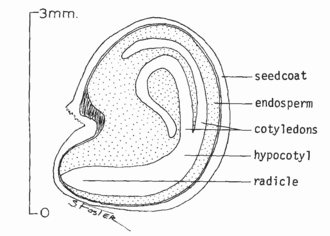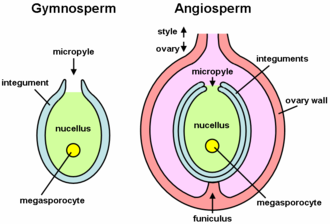AY Honors/Seeds - Advanced/Answer Key
From Pathfinder Wiki
< AY Honors | Seeds - AdvancedAY Honors/Seeds - Advanced/Answer Key /
1. Have the Seeds Honor
2. Identify from drawings and know the purpose of each of the following parts of a seed: endosperm, radicle, plumule, micropyle.
- Endosperm
- Endosperm is the tissue produced in the seeds of most flowering plants around the time of fertilization. It surrounds the embryo and provides nutrition in the form of starch, though it can also contain oils and protein.
- Radicle
- The radicle is the first part of a seedling (a growing plant embryo) to emerge from the seed during the process of germination. The radicle is the embryonic root of the plant, and grows downward in the soil.
- Plumule
- The plumule is the embryonic shoot. It is the precursor to the stem and leaves of the plant.
- Micropyle
- The micropyle is an opening in a plant's ovule (the structure that gives rise to and contains the female reproductive cells). The micropyle opening allows the pollen tube to enter the ovule for fertilization. In gymnosperms (e.g. conifers), the pollen itself is drawn into the ovule and the micropyle opening closes after pollination. During germination, the seedling's radicle emerges through the micropyle.
3. Know several differences between a monocotyledon seed and a dicotyledon seed, and give three examples of each.
4. Explain the purpose and use of a "rag doll" seed tester. Use it to test the germination of 100 seeds of a wild plant and 100 seeds of a domestic plant. Report the results of each test.
5. How does a seed differ from a spore?
6. Write or tell orally two spiritual lessons we may learn from seeds. You will find help in Christ's Object Lessons by Ellen G. White, pages 33 to 89.
7. Make a collection of 60 different kinds of seeds, of which only 15 may be collected from commercial seed packages, the other 45 you are to collect yourself. Label each kind as follows: seed name, date collected, location collected, and collector’s name.
Adventist Youth Honors Answer Book/Nature/Seeds/Seed collection



